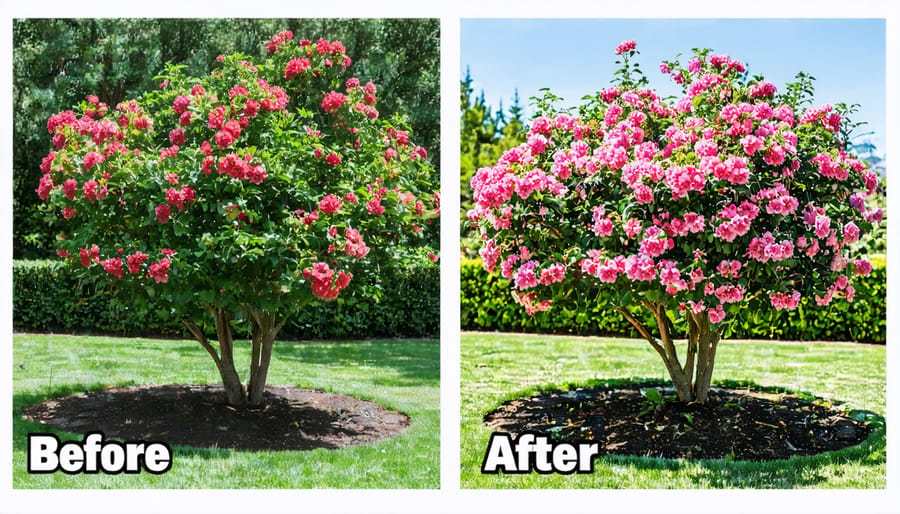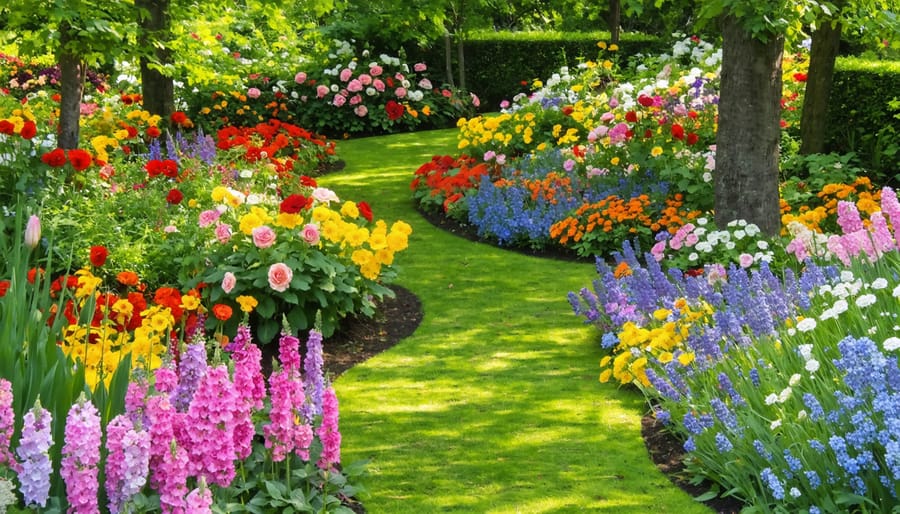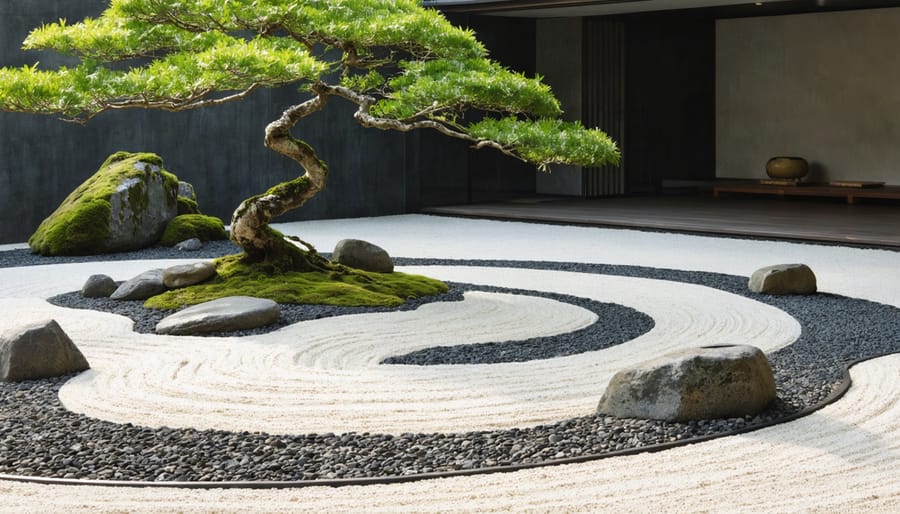Nature’s most exquisite artists work in petals and stems, transforming ordinary gardens into living masterpieces that captivate all who encounter them. Like skilled painters wielding colors across a canvas, flowers possess an innate ability to create a peaceful garden sanctuary through their thoughtful arrangement, harmonious color combinations, and ever-changing seasonal displays.
Beyond their individual beauty, flowers speak a universal language of emotion and connection, expressing joy, serenity, and wonder through their intricate forms and delicate textures. From the mathematical precision of a sunflower’s spiral to the graceful arc of a climbing rose, these natural wonders demonstrate that true artistry doesn’t require a brush or chisel – simply soil, sunlight, and an understanding of nature’s fundamental design principles.
In our fast-paced digital world, the artistry of flowers offers a tangible reminder of beauty’s ephemeral nature and the profound impact of thoughtful garden design. Whether crafting a cottage garden bursting with cheerful blooms or sculpting a minimalist display of architectural plants, each gardener becomes both artist and curator, working in harmony with nature to create living compositions that evolve and enchant throughout the seasons.
The Elements of Floral Design
Color Theory in the Garden
Color theory in gardening is like painting with living brushstrokes, where each flower contributes to a larger artistic vision. Just as artists work with a color wheel, gardeners can use these same principles to create stunning visual effects that enhance the cultural significance of plants in their garden spaces.
Start with the basics of color relationships: complementary colors (those opposite each other on the color wheel) create bold, dramatic effects. Think purple iris against yellow daylilies, or orange marigolds alongside blue delphiniums. For a more peaceful atmosphere, try analogous colors – those that sit next to each other on the wheel, like purple, blue, and pink flowers that create a cooling, harmonious effect.
White flowers act as natural mediators, offering visual breaks between bold color combinations and lighting up shady corners. They’re particularly magical during twilight hours when they seem to glow in the fading light. For year-round interest, consider the changing colors of foliage alongside your blooms.
Remember that colors appear differently depending on lighting conditions. Morning sun brings out cool tones, while evening light enhances warm colors. Start small with a single color scheme in one bed, then expand as you become more confident. The joy of gardening is that nothing is permanent – you can always move plants around until you achieve your perfect palette.

Texture and Form
The interplay of different textures and forms in flower arrangements creates a captivating visual symphony that draws the eye and holds interest throughout the seasons. From the delicate, lacy blooms of Queen Anne’s Lace to the bold, structural presence of sunflowers, each flower brings its unique character to the garden canvas.
When planning your floral display, consider incorporating a variety of shapes: spikes like delphiniums and snapdragons add vertical drama, while round forms like zinnias and dahlias create focal points. Umbrella-shaped flowers such as yarrow and elderberry offer an airy, floating quality that softens harder edges in your garden design.
Texture plays an equally important role in creating depth and interest. Combine soft, fuzzy elements like lamb’s ear or dusty miller with smooth, glossy leaves of camellias or gardenias. Consider how light plays across different surfaces – the velvet petals of roses catch morning dew differently than the papery blooms of poppies.
Layer your plantings with contrasting textures to create visual movement. Place feathery astilbe near bold-leaved hostas, or pair the delicate sprays of baby’s breath with the substantial blooms of peonies. This thoughtful combination of different flower forms and textures creates a rich tapestry that changes throughout the day as light shifts and shadows play across your garden.
Remember that even simple flowers can create stunning effects when grouped strategically, allowing their natural forms to complement each other in an artistic display.
Creating Living Compositions
Layering and Height
Creating depth and dimension in your flower garden is like painting on a three-dimensional canvas. By thoughtfully arranging plants of varying heights, you can transform a flat garden bed into a captivating visual journey that draws the eye through multiple layers of beauty. This technique is particularly effective in creating meditative garden spaces that invite contemplation and wonder.
Start with your tallest plants at the back of borders or in the center of island beds. Consider graceful ornamental grasses, sturdy delphiniums, or towering hollyhocks as your backdrop. These create a natural “wall” that adds privacy while setting the stage for shorter companions. In the middle ground, plant medium-height perennials like coneflowers, salvias, and shasta daisies, allowing them to weave naturally between taller and shorter specimens.
Reserve the front edges for low-growing plants that spill and spread, such as creeping phlox, alyssum, or prostrate rosemary. This creates a soft transition between pathways and taller plantings. Don’t forget to include plants with varying forms – spiky, mounding, and trailing – to add extra visual interest between the layers.
Remember that successful layering isn’t just about height – consider bloom times, colors, and textures as you plan. When these elements work together, they create a garden that feels both natural and artistically composed, offering different perspectives and discoveries as you move through the space.

Seasonal Symphony
Creating a garden that blooms throughout the year is like conducting a symphony, where each plant plays its part at precisely the right moment. The key to achieving this perpetual display lies in thoughtful planning and strategic plant selection.
Begin your year-round garden composition with early spring bulbs like snowdrops and crocuses, which peek through the last traces of winter frost. As temperatures warm, let daffodils and tulips take center stage, their vibrant colors announcing spring’s arrival. Late spring brings the dramatic flourishes of peonies and irises, creating layers of color and texture.
Summer’s movement features the bold performances of daylilies, coneflowers, and lavender, accompanied by the steady rhythm of repeat-blooming roses. As autumn approaches, asters and chrysanthemums step into the spotlight, while ornamental grasses add movement and structure to your garden’s composition.
Even winter can showcase subtle beauty through evergreens, witch hazel, and winter jasmine. Consider incorporating plants with interesting bark, berries, or seed heads to maintain visual interest during dormant months.
To orchestrate this continuous display, map out your garden’s bloom times on a calendar. Group plants with complementary flowering periods, and ensure each season has its starring performers. Remember to factor in plant heights, colors, and textures to create harmonious combinations that flow seamlessly from one season to the next.
Focal Points and Flow
Creating visual interest in your garden starts with understanding how to guide the eye through your floral landscape. Just as artists use leading lines and focal points in paintings, gardeners can apply similar historical garden design principles to create stunning outdoor spaces.
Begin by establishing a primary focal point – perhaps a striking Japanese maple, a dramatic flowering shrub, or an artistic garden structure. Position this feature where it naturally draws attention, typically at the end of a pathway or at the garden’s center. Remember, your focal point should be visible from multiple angles and change with the seasons.
Create movement through your garden by varying plant heights and textures. Tall, graceful ornamental grasses can lead the eye upward, while flowing groundcovers guide visitors along winding paths. Plant in sweeping curves rather than straight lines to establish a more natural, dynamic feel.
Consider the natural flow of your space by positioning plants in graduated heights – shorter flowers in front, medium-height plants in the middle, and taller specimens at the back. This tiered approach not only creates depth but ensures all your flowers receive adequate sunlight and attention.
Don’t forget to include resting points where the eye can pause and appreciate individual blooms. Small seating areas or artistic elements like bird baths can serve as secondary focal points, creating a journey through your garden that unfolds naturally and keeps visitors engaged.
Maintaining Your Living Masterpiece
Pruning for Perfection
Pruning is where gardening truly becomes an art form, transforming ordinary plants into living sculptures. The key to successful pruning lies in understanding your plant’s natural growth pattern and working with it, rather than against it. Start by removing dead or damaged branches, making clean cuts at a 45-degree angle just above a leaf node or bud.
For flowering shrubs, timing is everything. Spring-blooming plants should be pruned immediately after flowering, while summer bloomers benefit from early spring pruning. When shaping, step back frequently to assess your work from different angles – just as an artist steps back from their canvas.
Remember the rule of thirds: never remove more than one-third of the plant at once. This maintains the plant’s health while allowing you to gradually achieve your desired shape. For formal gardens, regular light trimming creates crisp lines and defined forms. For a more natural look, selective pruning helps maintain the plant’s inherent grace while controlling its size.
Essential tools include sharp bypass pruners for smaller branches, loppers for thicker stems, and pruning saws for major limbs. Always keep your tools clean and sharp – clean cuts heal faster and look better. As you gain confidence, try your hand at more advanced techniques like crown thinning or topiary shaping, but remember that sometimes less is more.

The Art of Deadheading
Deadheading is like conducting an orchestra in your garden, ensuring each flower performs at its peak while maintaining visual harmony. This simple yet artistic practice involves removing spent blooms before they go to seed, redirecting the plant’s energy into producing new flowers rather than forming seeds.
The technique varies by flower type, but the principle remains the same: pinch or snip the faded bloom just above the nearest set of healthy leaves or emerging buds. For roses, make your cut at a 45-degree angle above an outward-facing leaf node to encourage balanced growth. With smaller flowers like marigolds and zinnias, a gentle pinch between your thumb and forefinger is all you need.
Timing is everything in the art of deadheading. Make it a meditative morning ritual, inspecting your garden while enjoying your coffee. Remove blooms as soon as they start to fade but before they form seedheads. This not only keeps your garden looking fresh but also prevents self-seeding plants from spreading too enthusiastically.
Some plants, like lavender and salvias, benefit from being cut back by a third after their first flush of flowers, encouraging a second spectacular show. However, if you’re hoping to attract birds or create winter interest, consider leaving some seedheads intact, especially on plants like echinacea and rudbeckia.
Remember, deadheading isn’t just maintenance – it’s an opportunity to connect with your garden and shape its ongoing performance.
Natural Frame Management
Creating a natural frame around your garden artwork adds the perfect finishing touch to your floral masterpiece. Think of your garden’s borders and edges as the mat and frame that complement a beautiful painting. These boundaries not only define your space but also enhance the overall visual impact of your flower arrangements.
Start by establishing clear sight lines using varying plant heights. Place taller plants like ornamental grasses or climbing roses at the back of borders, gradually stepping down to medium-height perennials, and finally edging with low-growing plants like creeping thyme or sweet alyssum. This natural progression draws the eye inward and creates depth in your garden canvas.
Consider using permanent elements like decorative stones, weathered logs, or classic brick edging to provide year-round structure. These hardscape features maintain clean lines even when plants are dormant and offer an elegant contrast to your flowing flower arrangements.
For a more organic look, allow some plants to softly spill over pathways or blur boundary lines. Plants like lavender or catmint create a gentle transition between different garden areas while maintaining a sense of intentional design. Remember to regularly trim these overflow areas to keep them looking purposeful rather than untidy.
Seasonal maintenance is key to preserving your garden’s frame. Deadhead spent blooms, trim back overgrown sections, and reshape edges every few weeks during the growing season. This ongoing care ensures your garden’s natural frame continues to showcase your floral artistry at its best.
As we’ve explored throughout this journey into floral artistry, your garden is more than just a collection of plants – it’s your personal canvas waiting to be transformed into a living masterpiece. Each flower you choose, every color combination you create, and all the textural elements you incorporate contribute to a unique artistic expression that reflects your personality and vision.
Remember that like any art form, garden design is an ever-evolving process. Don’t be afraid to experiment with different combinations, move plants around, or try new varieties that catch your eye. Your garden is a dynamic creation that changes with the seasons, offering endless opportunities for creative expression.
Take inspiration from the principles we’ve discussed – color theory, balance, rhythm, and contrast – but don’t feel bound by rules. The most memorable gardens often break conventional wisdom to create something truly special. Trust your instincts and let your creativity flow freely.
Consider documenting your garden’s evolution through photographs or sketches. This not only helps you track your progress but also allows you to appreciate the artistic journey you’re undertaking. Share your successes and learning experiences with fellow gardeners, and draw inspiration from their creative approaches as well.
As you tend to your garden, remember that you’re not just maintaining plants – you’re nurturing a living work of art that brings joy to everyone who experiences it. Let your garden be an extension of your artistic spirit, and watch as it blooms into something truly extraordinary.




